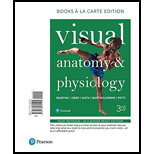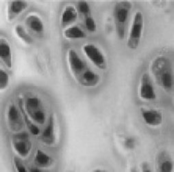
EBK VISUAL ANATOMY & PHYSIOLOGY
3rd Edition
ISBN: 9780134511191
Author: Petti
Publisher: YUZU
expand_more
expand_more
format_list_bulleted
Concept explainers
Question
Chapter 4, Problem 1CRQ
Summary Introduction
To identify: The category of the given cartilage.
Introduction: A cartilage is a type of supporting connective tissue, which is generally smooth and rubber like structure that provides paddling by protecting and covering the ends of the long bones at joints. Cartilages are the structural component of the ribs, nose, ear, intervertebral discs, and bronchial tubes.
Expert Solution & Answer
Answer to Problem 1CRQ
Pictorial representation: Fig.1 represents the hyaline cartilage

Fig.1: Hyaline cartilage
Explanation of Solution
The hyaline cartilage provides stiffness although it is somewhat flexible. This cartilage also helps to reduce the friction between bony surfaces. It is found to occur in the following regions:
- Region between the tips of the ribs and bones present in the sternum.
- Respiratory passageways.
- Bones of the movable joints.
- Nasal septum.
Want to see more full solutions like this?
Subscribe now to access step-by-step solutions to millions of textbook problems written by subject matter experts!
Students have asked these similar questions
Ch.23
How is Salmonella able to cross from the intestines into the blood?
A. it is so small that it can squeeze between intestinal cells
B. it secretes a toxin that induces its uptake into intestinal epithelial cells
C. it secretes enzymes that create perforations in the intestine
D. it can get into the blood only if the bacteria are deposited directly there, that is, through a puncture
—
Which virus is associated with liver cancer?
A. hepatitis A
B. hepatitis B
C. hepatitis C
D. both hepatitis B and C
—
explain your answer thoroughly
Ch.21
What causes patients infected with the yellow fever virus to turn yellow (jaundice)?
A. low blood pressure and anemia
B. excess leukocytes
C. alteration of skin pigments
D. liver damage in final stage of disease
—
What is the advantage for malarial parasites to grow and replicate in red blood cells?
A. able to spread quickly
B. able to avoid immune detection
C. low oxygen environment for growth
D. cooler area of the body for growth
—
Which microbe does not live part of its lifecycle outside humans?
A. Toxoplasma gondii
B. Cytomegalovirus
C. Francisella tularensis
D. Plasmodium falciparum
—
explain your answer thoroughly
Ch.22
Streptococcus pneumoniae has a capsule to protect it from killing by alveolar macrophages, which kill bacteria by…
A. cytokines
B. antibodies
C. complement
D. phagocytosis
—
What fact about the influenza virus allows the dramatic antigenic shift that generates novel strains?
A. very large size
B. enveloped
C. segmented genome
D. over 100 genes
—
explain your answer thoroughly
Chapter 4 Solutions
EBK VISUAL ANATOMY & PHYSIOLOGY
Ch. 4.1 - Prob. 1RCh. 4.1 - Prob. 2RCh. 4.1 - Prob. 3RCh. 4.1 - Prob. 4RCh. 4.1 - Prob. 5RCh. 4.1 - Prob. 6RCh. 4.1 - B. Summarize the classification of an epithelium...Ch. 4.1 - A. Identify the various types of epithelial...Ch. 4.1 - Prob. 9RCh. 4.1 - Prob. 10R
Ch. 4.1 - Prob. 11RCh. 4.1 - Prob. 12RCh. 4.1 - Prob. 13RCh. 4.1 - Prob. 14RCh. 4.1 - Prob. 15RCh. 4.1 - Prob. 16RCh. 4.1 - A. Describe the appearance of simple columnar...Ch. 4.1 - Prob. 18RCh. 4.1 - Prob. 19RCh. 4.1 - Prob. 20RCh. 4.1 - Prob. 1LOCh. 4.1 - Prob. 2LOCh. 4.1 - Prob. 3LOCh. 4.1 - Prob. 4LOCh. 4.1 - Prob. 5LOCh. 4.1 - Prob. 6LOCh. 4.1 - Prob. 7LOCh. 4.1 - Prob. 8LOCh. 4.1 - Prob. 9LOCh. 4.1 - Prob. 1ICh. 4.1 - Prob. 2ICh. 4.1 - Prob. 3ICh. 4.1 - Prob. 4ICh. 4.1 - Prob. 5ICh. 4.1 - Prob. 6ICh. 4.1 - Prob. 1SRCh. 4.1 - Prob. 2SRCh. 4.1 - Prob. 3SRCh. 4.1 - Prob. 4SRCh. 4.1 - Prob. 5SRCh. 4.1 - Prob. 6SRCh. 4.1 - Prob. 7SRCh. 4.1 - Prob. 18SRCh. 4.1 - Prob. 19SRCh. 4.1 - Prob. 20SRCh. 4.1 - Prob. 21SRCh. 4.1 - Prob. 22SRCh. 4.1 - Prob. 23SRCh. 4.1 - Prob. 24SRCh. 4.1 - Prob. 25SRCh. 4.2 - Prob. 1RCh. 4.2 - Prob. 2RCh. 4.2 - Prob. 3RCh. 4.2 - Prob. 4RCh. 4.2 - Prob. 5RCh. 4.2 - Prob. 6RCh. 4.2 - Summarize the role of extracellular fluid in...Ch. 4.2 - Prob. 8RCh. 4.2 - Prob. 9RCh. 4.2 - Prob. 10RCh. 4.2 - Prob. 11RCh. 4.2 - Prob. 12RCh. 4.2 - Prob. 13RCh. 4.2 - Prob. 14RCh. 4.2 - Prob. 15RCh. 4.2 - Prob. 1LOCh. 4.2 - Prob. 2LOCh. 4.2 - Prob. 3LOCh. 4.2 - Prob. 4LOCh. 4.2 - Describe the structure and function of bone.
Ch. 4.2 - Prob. 6LOCh. 4.2 - Prob. 1ICh. 4.2 - Prob. 2ICh. 4.2 - Prob. 3ICh. 4.2 - Prob. 4ICh. 4.2 - Prob. 1SRCh. 4.2 - Prob. 11SRCh. 4.2 - Prob. 12SRCh. 4.2 - Prob. 13SRCh. 4.2 - Prob. 14SRCh. 4.2 - Prob. 15SRCh. 4.2 - Prob. 16SRCh. 4.2 - Prob. 17SRCh. 4.2 - Prob. 18SRCh. 4.2 - Prob. 19SRCh. 4.2 - Prob. 20SRCh. 4.2 - Prob. 21SRCh. 4.2 - Prob. 22SRCh. 4.3 - Prob. 1RCh. 4.3 - Prob. 2RCh. 4.3 - Prob. 3RCh. 4.3 - Prob. 4RCh. 4.3 - Prob. 5RCh. 4.3 - Prob. 6RCh. 4.3 - Prob. 1LOCh. 4.3 - Prob. 2LOCh. 4.3 - Prob. 3LOCh. 4.3 - Prob. 1ICh. 4.3 - Prob. 2ICh. 4.3 - Prob. 1SRCh. 4.3 - Prob. 13SRCh. 4.3 - Prob. 14SRCh. 4.3 - Prob. 15SRCh. 4.3 - Prob. 16SRCh. 4.3 - Prob. 17SRCh. 4.3 - Prob. 18SRCh. 4.3 - Prob. 19SRCh. 4.3 - Prob. 20SRCh. 4 - Prob. 1CRQCh. 4 - Prob. 2CRQCh. 4 - Prob. 3CRQCh. 4 - Prob. 4CRQCh. 4 - Prob. 5CRQCh. 4 - Prob. 6CRQCh. 4 - Prob. 7CRQCh. 4 - Prob. 8CRQCh. 4 - Prob. 9CRQCh. 4 - Prob. 10CRQCh. 4 - Prob. 11CRQCh. 4 - Prob. 12CRQCh. 4 - Prob. 13CRQCh. 4 - Prob. 14CRQCh. 4 - Prob. 15CRQCh. 4 - Prob. 16CRQCh. 4 - Prob. 17CRQCh. 4 - Prob. 18CRQCh. 4 - Prob. 19CRQCh. 4 - Prob. 20CRQCh. 4 - Prob. 21CRQCh. 4 - Prob. 22CRQCh. 4 - Prob. 23CRQCh. 4 - Prob. 24CRQCh. 4 - Prob. 25CRQCh. 4 - Prob. 26CRQCh. 4 - Prob. 27CRQCh. 4 - Prob. 28CRQCh. 4 - Prob. 29CRQCh. 4 - Prob. 1CICh. 4 - Prob. 2CI
Knowledge Booster
Learn more about
Need a deep-dive on the concept behind this application? Look no further. Learn more about this topic, biology and related others by exploring similar questions and additional content below.Similar questions
- What is this?arrow_forwardMolecular Biology A-C components of the question are corresponding to attached image labeled 1. D component of the question is corresponding to attached image labeled 2. For a eukaryotic mRNA, the sequences is as follows where AUGrepresents the start codon, the yellow is the Kozak sequence and (XXX) just represents any codonfor an amino acid (no stop codons here). G-cap and polyA tail are not shown A. How long is the peptide produced?B. What is the function (a sentence) of the UAA highlighted in blue?C. If the sequence highlighted in blue were changed from UAA to UAG, how would that affecttranslation? D. (1) The sequence highlighted in yellow above is moved to a new position indicated below. Howwould that affect translation? (2) How long would be the protein produced from this new mRNA? Thank youarrow_forwardMolecular Biology Question Explain why the cell doesn’t need 61 tRNAs (one for each codon). Please help. Thank youarrow_forward
- Molecular Biology You discover a disease causing mutation (indicated by the arrow) that alters splicing of its mRNA. This mutation (a base substitution in the splicing sequence) eliminates a 3’ splice site resulting in the inclusion of the second intron (I2) in the final mRNA. We are going to pretend that this intron is short having only 15 nucleotides (most introns are much longer so this is just to make things simple) with the following sequence shown below in bold. The ( ) indicate the reading frames in the exons; the included intron 2 sequences are in bold. A. Would you expected this change to be harmful? ExplainB. If you were to do gene therapy to fix this problem, briefly explain what type of gene therapy youwould use to correct this. Please help. Thank youarrow_forwardMolecular Biology Question Please help. Thank you Explain what is meant by the term “defective virus.” Explain how a defective virus is able to replicate.arrow_forwardMolecular Biology Explain why changing the codon GGG to GGA should not be harmful. Please help . Thank youarrow_forward
- Stage Percent Time in Hours Interphase .60 14.4 Prophase .20 4.8 Metaphase .10 2.4 Anaphase .06 1.44 Telophase .03 .72 Cytukinesis .01 .24 Can you summarize the results in the chart and explain which phases are faster and why the slower ones are slow?arrow_forwardCan you circle a cell in the different stages of mitosis? 1.prophase 2.metaphase 3.anaphase 4.telophase 5.cytokinesisarrow_forwardWhich microbe does not live part of its lifecycle outside humans? A. Toxoplasma gondii B. Cytomegalovirus C. Francisella tularensis D. Plasmodium falciparum explain your answer thoroughly.arrow_forward
- Select all of the following that the ablation (knockout) or ectopoic expression (gain of function) of Hox can contribute to. Another set of wings in the fruit fly, duplication of fingernails, ectopic ears in mice, excess feathers in duck/quail chimeras, and homeosis of segment 2 to jaw in Hox2a mutantsarrow_forwardSelect all of the following that changes in the MC1R gene can lead to: Changes in spots/stripes in lizards, changes in coat coloration in mice, ectopic ear formation in Siberian hamsters, and red hair in humansarrow_forwardPleiotropic genes are genes that (blank) Cause a swapping of organs/structures, are the result of duplicated sets of chromosomes, never produce protein products, and have more than one purpose/functionarrow_forward
arrow_back_ios
SEE MORE QUESTIONS
arrow_forward_ios
Recommended textbooks for you
 Human Anatomy & Physiology (11th Edition)BiologyISBN:9780134580999Author:Elaine N. Marieb, Katja N. HoehnPublisher:PEARSON
Human Anatomy & Physiology (11th Edition)BiologyISBN:9780134580999Author:Elaine N. Marieb, Katja N. HoehnPublisher:PEARSON Biology 2eBiologyISBN:9781947172517Author:Matthew Douglas, Jung Choi, Mary Ann ClarkPublisher:OpenStax
Biology 2eBiologyISBN:9781947172517Author:Matthew Douglas, Jung Choi, Mary Ann ClarkPublisher:OpenStax Anatomy & PhysiologyBiologyISBN:9781259398629Author:McKinley, Michael P., O'loughlin, Valerie Dean, Bidle, Theresa StouterPublisher:Mcgraw Hill Education,
Anatomy & PhysiologyBiologyISBN:9781259398629Author:McKinley, Michael P., O'loughlin, Valerie Dean, Bidle, Theresa StouterPublisher:Mcgraw Hill Education, Molecular Biology of the Cell (Sixth Edition)BiologyISBN:9780815344322Author:Bruce Alberts, Alexander D. Johnson, Julian Lewis, David Morgan, Martin Raff, Keith Roberts, Peter WalterPublisher:W. W. Norton & Company
Molecular Biology of the Cell (Sixth Edition)BiologyISBN:9780815344322Author:Bruce Alberts, Alexander D. Johnson, Julian Lewis, David Morgan, Martin Raff, Keith Roberts, Peter WalterPublisher:W. W. Norton & Company Laboratory Manual For Human Anatomy & PhysiologyBiologyISBN:9781260159363Author:Martin, Terry R., Prentice-craver, CynthiaPublisher:McGraw-Hill Publishing Co.
Laboratory Manual For Human Anatomy & PhysiologyBiologyISBN:9781260159363Author:Martin, Terry R., Prentice-craver, CynthiaPublisher:McGraw-Hill Publishing Co. Inquiry Into Life (16th Edition)BiologyISBN:9781260231700Author:Sylvia S. Mader, Michael WindelspechtPublisher:McGraw Hill Education
Inquiry Into Life (16th Edition)BiologyISBN:9781260231700Author:Sylvia S. Mader, Michael WindelspechtPublisher:McGraw Hill Education

Human Anatomy & Physiology (11th Edition)
Biology
ISBN:9780134580999
Author:Elaine N. Marieb, Katja N. Hoehn
Publisher:PEARSON

Biology 2e
Biology
ISBN:9781947172517
Author:Matthew Douglas, Jung Choi, Mary Ann Clark
Publisher:OpenStax

Anatomy & Physiology
Biology
ISBN:9781259398629
Author:McKinley, Michael P., O'loughlin, Valerie Dean, Bidle, Theresa Stouter
Publisher:Mcgraw Hill Education,

Molecular Biology of the Cell (Sixth Edition)
Biology
ISBN:9780815344322
Author:Bruce Alberts, Alexander D. Johnson, Julian Lewis, David Morgan, Martin Raff, Keith Roberts, Peter Walter
Publisher:W. W. Norton & Company

Laboratory Manual For Human Anatomy & Physiology
Biology
ISBN:9781260159363
Author:Martin, Terry R., Prentice-craver, Cynthia
Publisher:McGraw-Hill Publishing Co.

Inquiry Into Life (16th Edition)
Biology
ISBN:9781260231700
Author:Sylvia S. Mader, Michael Windelspecht
Publisher:McGraw Hill Education
Types of Human Body Tissue; Author: MooMooMath and Science;https://www.youtube.com/watch?v=O0ZvbPak4ck;License: Standard YouTube License, CC-BY